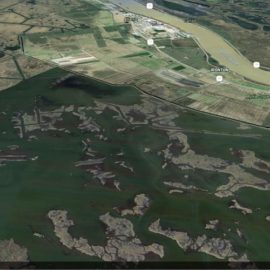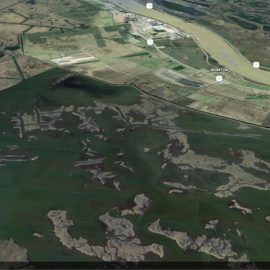
Google Earth
One man disagrees with the state and the corps as well as environmentalists on the way to build land. You can tell where he comes from by those he cites.
There are better ways to rebuild Louisiana’s wetlands. It’s not too late to stop a long-imagined but misguided $2 billion project to divert up to 75,000 cubic feet per second of the Mississippi River into the Barataria Basin to replenish disappearing marsh. The public comment period with the U.S. Army Corps of Engineers for the Mid-Barataria Sediment Diversion Project ends Monday. Despite the decades of planning that have gone into the project, the Corps should not approve it right now. Critics such as Lt. Gov. Billy Nungesser have raised too many good objections. More important, alternatives exist that could rebuild wetlands faster, at a lesser cost, and without the environmental harms the diversion will create.
nola.com
He states his long time support of diversions but not this one.
I write this as a 35-year-long cheerleader for diversion projects for wetlands restoration. It is incontrovertible that a major reason for wetlands loss is the man-made levee system that keeps the Mississippi from regularly overflowing its banks and sending sediment-rich water into south Louisiana’s marshes. For decades, coastal restorationists have reasoned that man could reintroduce nature’s designs by re-engineering the levee system to re-provide part of the former sediment flow. Alas, that theory isn’t well-tested. Cheerleading must bow to empirical evidence. Prior, smaller diversion projects have seen mixed results. Several respected oceanographers say the diversion would destroy more wetlands than it would save. Plus, for millions of years, the river’s water and sediments carried no pesticides and herbicides, not to mention other toxic chemicals. Now they do. And everybody agrees the sudden reintroduction of fresh water (along with the chemicals) will virtually wipe out populations of dolphins (about 2,000), oysters and shrimp in the basin, and probably also harm trout and other fish. As has been well reported, the water from the 2019 opening of the Bonnet Carre Spillway caused horrid suffering and death of dolphins and some $256 million in damages to fisheries overall. A separate breach at Mardi Gras Pass played havoc with oyster reefs in Breton Sound. Equally well reported has been the battle between the diversion project’s advocates and adversaries. The former include engineering firms hoping for business and well-intentioned public officials with massive intellectual and sweat equity in the project. On the other side, fishing, restaurant and tourist industries, some major wildlife groups and several parish governments fear catastrophic ecological and economic damage to fisheries.
This is not an all of nothing problem. There are other solutions.
Far less well reported is that this need not be an all-or-nothing choice between fisheries and wetlands. If the $2 billion is repurposed, there are ways to rebuild the latter without devastating the former. Abandoned oil pipeline canals that helped cause erosion could be backfilled from soil banks. Sediment directly dredged from the Mississippi River or from offshore can be used to build new land, without the fresh water that ruins salinity levels. Berms, some of them “forested” with young trees, can be built as breakwaters to block incoming storm surges while keeping wave action from carrying soil out to sea. And new oyster reefs, which also serve as breakwaters, can be seeded with live larvae introduced to crushed stone. And if bureaucrats get out of the way, private companies can do the dredging and filling by contracting with the state while buying property from existing owners, all with greater efficiency and less cost than if the state had to manage all the projects itself. For example, former Obama Environmental Quality honcho Tim Male, now of the Environmental Policy Innovation Center, argues strenuously for the cost-efficacy of private contracting. We know private contracting has worked for wetlands mitigation projects for years. Pipelines can deliver slurry for marsh rebuilding that is quicker and less expensive. We know the restoration of Queen Bess (Pelican) Island and Shell Island, both using dredged material, have been tremendously successful, remarkably quickly and cost-effectively.
Diversions are costly both in the actual cost and the economic cost of this one.
The diversion projects are “a very expensive experiment,” said Michael Ellison, a former executive director for Louisiana’s Coastal Protection Restoration Authority and former director of mitigation services in the state of North Carolina. “But there’s no accountability if it doesn’t work.” Ellison, now a consultant who has no clients in Louisiana (and thus no financial biases), said it makes more sense to pump sediments from the Mississippi River than to do a major project diverting the flow of river water. The dredge-and-pump solution, he said, is “one of the most useful tools in the box. It’s faster. It’s proven, everybody down there knows how to do it. They have been doing it a long time …. And it’s an alternative that does not cost $2 billion to test.”
This is the first negative piece were a myriad of options were presented. Some are being done nos, plugging some wells, and others such as filling in the dredged canals also have been done but not to a large scale. His mention of these goes back to my question, why were not the oil companies told to do this work when they stopped drilling in an area?



